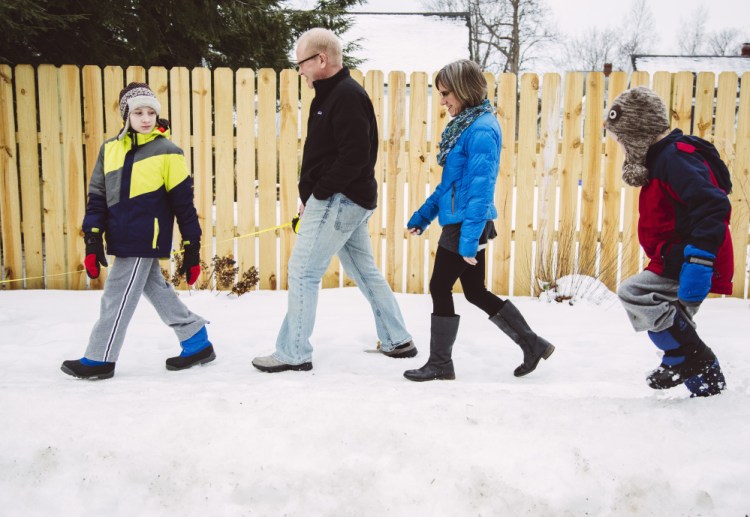Heather Moore Wood and David Wood set three top priorities as they began looking for a new place to live in Portland. They wanted an old house big enough for their family of four in a walkable neighborhood.
“I just love the lifestyle of not having to get in a car anytime we want to go anywhere,” Moore Wood said. “It’s fun to walk to the corner store with my kids for milk instead of driving to Hannaford. I love the thought of the kids being able to walk to school, walk to the library, not having to drive to go out to dinner occasionally.”
The Woods are not alone in wanting a home in a place where they can easily walk. Houses in greater Portland advertised recently on Zillow.com included these enticements:
“Steps to the Greenbelt walking trail” in South Portland.
“Neighborhood access to Robinson Woods & Cape (Elizabeth) trail system.”
“Within walking distance of the Mountain Division Trail” in Windham.
“All lots abut open space with a nature trail” in Freeport.
“You’re able to stroll to the bakeries and restaurants, walk to the park and bike through an endless trail system, all within 5 minutes of downtown Portland.”
The Eastern Village development touts its location “in the center of Scarborough, on the Eastern Trail.” An hour to the North, home sellers in Gardiner, Hallowell, Augusta and Farmingdale often mention their proximity to the 6.5-mile Kennebec River Rail Trail.
Bill Sprague, an Augusta-area realtor, says he has seen a growing interest in walking and bicycling during his 35 years in the business.
“I haven’t noticed that walkability or bikeability alone directly affect home values, ” he said. “But they would tend to add to what many people would enjoy in a home – (a) good area, quiet, proximity to amenities, not a lot of traffic, family friendly.”
David Marsden, a real estate broker in greater Portland, considers it “a huge positive” to market a home as being within a quarter-mile of a trailhead.
Marsden sees a trend of people choosing to live in cities such as Portland where they can get around easily on foot or bicycle. “Empty nesters are selling their houses in the suburbs and moving in-town,” he reports
That trend is prevalent around the world. A prime example is Stockholm, Sweden, which bills itself as “The Walkable City.”
Stockholm has taken many steps to limit cars and driving, such as lowering speed limits and closing some streets to cars. Drivers must pay a toll to enter the central city. While most residents opposed the toll before it went into effect a decade ago, most now support it, according to a March 2015 article in CityLab.com.
The consulting firm Spacescape found a correlation between high real estate values in Stockholm and the ability to walk to parks, stores and other services.
“Stockholm is one of Europe’s fastest-growing cities, and its property market is driven by walkability,” the firm’s Alexander Ståhle told CityLab.com. The article pointed out how cities in the United States such as New York are trying to incorporate some of Stockholm’s successful ideas into their own urban planning.
Heather Moore Wood said she and her husband chose to relocate from the Boston suburbs to Portland in 2004 in part because of the ease of getting around without a car. David Wood commutes by bicycle to his job in the Old Port year-round. Moore Wood bicycles to her job downtown in the warmer months.
When they looked for their first house, she says, “I remember wanting to be within walking distance of a corner store, a school and ice cream.” They found a house in the Riverton neighborhood near a store and school.
Since moving to Deering Center last summer, Moore Wood said, “we have ice cream, too.”
The advantages of living in a walkable neighborhood go beyond saving money, getting exercise and reducing pollution. People feel more connected to their community when they see neighborhood children walking to school in the morning, or couples strolling to the local coffee shop.
“It feels like a neighborhood,” said Moore Wood, “when you sit on the front porch and see neighbors walk by.”
Last summer, she was reading a Beverly Cleary book to her sons when one of her neighbors passed by. The neighbor sat down and joined them on the porch for story time.
Now, isn’t that the kind of neighborhood where you want to live?
Shoshana Hoose is a freelance writer who walks and bicycles in Greater Portland and beyond. Contact her at shoshanahoose@gmail.com.
Send questions/comments to the editors.



Success. Please wait for the page to reload. If the page does not reload within 5 seconds, please refresh the page.
Enter your email and password to access comments.
Hi, to comment on stories you must . This profile is in addition to your subscription and website login.
Already have a commenting profile? .
Invalid username/password.
Please check your email to confirm and complete your registration.
Only subscribers are eligible to post comments. Please subscribe or login first for digital access. Here’s why.
Use the form below to reset your password. When you've submitted your account email, we will send an email with a reset code.